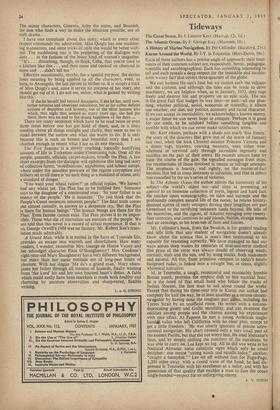Tideways
The Great Storm. By J. Lennox Kerr. (Harrap, 12s. 6c1.1 The Atlantic Ocean. By F. George Kay. (Museum, V, EACH of these authors has a precise angle of approach; their treat- ments of their common subject are, respectively, heroic, pedagogic, scientific and autobiographical. Each has something interesting to tell and each reveals a deep respect for the insatiable and incalcu- lable watery fact that covers three-quarters of the globe.
We can harness the sun's heat but we cannot curb the volcano and the cyclone, and although the tides can be made to drive machinery, we are helpless when, as in January, 1953, they rage freely and destroy life and property on an epic scale. The sea is the great fact that nudges its way into—or past—all our plan- ning, whether political, social, economic or scientific; it affects our weather, our diet, our politics, economy and racial character. If we can accept its inevitability, we acknowledge a known enemy, a major force we can never hope to conquer. Perhaps it is good for our souls, to be subdued before something tangible and terrible with which we can never make satisfactory terms.
Mr. Kerr relates, perhaps with a shade too much 'fine frenzy,' the story of the disasters that grew out of the storm of January last year, when the Irish Channel steamer Princess Victoria and a dozen tugs, trawlers, coasting steamers, were either over- whelmed or survived only through incredible ingenuity and sacrifice on the part of their crews. He records almost hour by hour the course of the gale, the signalled messages from ships, the recollections of those involved in rescue or salvage attempts. The emphasis is heavily, and rightly, on the matter-of-fact heroism that led in some instances to salvation, and that in others was cancelled by the sea's series of victories.
In The Atlantic Ocean the author admits the immensity of his subject—the world's oldest sea—and aims at presenting an aperitif to an immense collection of myth, legend and hard fact. He touches upon oceanography, on tides and currents and the profoundly complex natural life of the ocean; he relates history- dimmed stpries of early voyagers driving their longships out past Greenland to the terrifying unknown lands beyond. He tells of the incentives, and the wens, of Atlantic voyaging over twenty- four centuries, and Contrives to add islands, battles, strange vessels and air crossings, to his bran-tub of facts and fancies.
Mr. Collinder's book, from the Swedish, is for general reading and tells little that any student of navigation doesn't already know about the science that is man's best testimonial to his capacity for reasoning correctly. We have managed to find our ways across deep waters by centuries of trial-and-error method (the price of the error was always death) of observing winds, currents, stars and the sun, and by using marks, both man-made and natural. All this, from primitive compasi to today's nearly foolproof radar, is linked into a straight but, at times, slightly whimsical narrative.
M. le Toumelin, a tough, resourceful and reasonably humble Breton youth, provides the empiric dish to thiS nautical feast; he is the lateg of that small band who follow the tracks of Joshua Slocum, the first man to sail alone round the world. Except that during his three-year trip in Kurun our author had company for half the way, he at least qualifies a§ a serious circum- navigator by having done the toughest part ale, including the Torres Strait by an unofficial route. He writes with a not4too- deprecating gaiety and Gallic sensibility, and can re-create the oddities among people and the charms among his experiences with nice effect. At Papeete he met a young American single- . handeil sailor who left California with no clear plan, except to get a little freedom : 'He was utterly ignorant of precise agro- nomical navigation. His chart covered only a very small part of the eastern Pacific, but that did not worry him. He used Mercator's lines, and by simply shifting the numbers of the meridians, he was able to carry on. Lee kept no log. All he did was write in his Nautical Almanac some cabalistic signs which only he could decipher: one meant "strong winds and squalls today," another, "caught a tunnyfish." ' Lee set off without fuss for Pago-Pago, 1,200 miles away, with a casual wave of the hand; he had im- pressed le Toumelin with his excellence as a sailor, and with his possession of that quality that enables a man to face the ocean single-handed—respect for an unforgiving enemy.














































 Previous page
Previous page